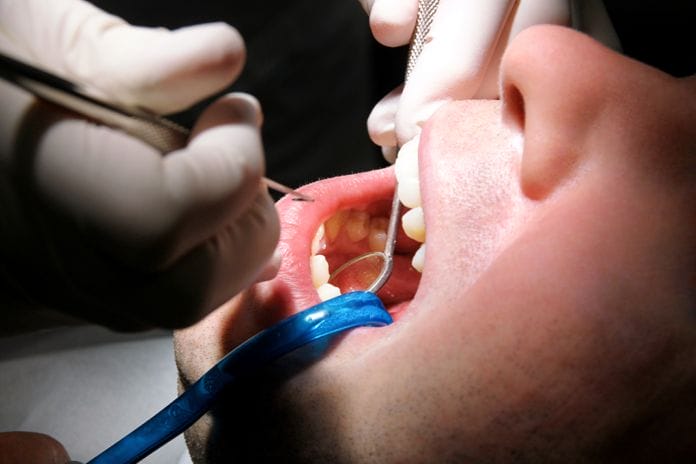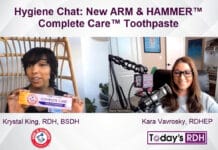By definition, the 4910 periodontal maintenance code is defined as the procedure following periodontal therapy and continues at varying intervals determined by the clinical evaluation. It includes removal of bacterial plaque, calculus, from supra and sub-regions, and SITE specific SRP where indicated, as well as polishing the teeth1. My focus this month is not to dissect the code and what it means or how to code, but to help hygienists perform the clinical procedure 4910 with efficiency and ease. After all, a maintenance appointment after four quads of SRP should be a breeze, right? So why is it some hygienists dread them on their schedule?
I spent about half my clinical career in periodontal practices, two to be specific. This long-term employment with periodontists allowed me to see the best and worst of periodontal disease and how to treat it. Twenty years later, what we know now is the days of aggressive osseous surgery have seen a shift to non-surgical treatment and proactive maintenance targeting biofilm. Hygienists are critical in this role. One of the things I personally loved about practicing in a perio office was the ability to see my patients from start to finish. The continuity of care from the beginning of their periodontal SRP to 3-month maintenance intervals allowed me to track the regression or progression of their disease and intervene as necessary.
Several coaches and consultants have ways to divide up your operatory time, and at best, any of these protocols are guidelines. These guidelines allow the practice to be on the same page systematically and helps calibrate your hygiene department. I too, as a consultant, provide timelines and time frames to help clinicians stay efficient. Now, everyone knows that each patient varies and so do circumstances in the schedule from day to day. So whatever timeline you use or have been given, I say go with it and just be flexible!
So what SHOULD you be covering in your 60-minute periodontal maintenance? The goal of periodontal maintenance is to maintain periodontal pockets by removing biofilm accumulation after initial periodontal therapy (SRP). Like any hygiene appointment, assessment is key. Full-mouth probing to identify target areas of inflammation, pocket depth, and calculus accumulation is imperative. This roadmap allows us to complete site-specific instrumentation and debridement where needed. My previous article on glycine air polishing points out the focus is predominately on biofilm disruption as the target of professional therapy. Therefore, we see the trend to begin debridement procedures with glycine air polishing.
Within your 60 minutes, of course, a comprehensive medical history review is indicated, as well as time for a doctor exam per your office protocols. It also includes the usual time between patient set up, break down, and the quick stop to the staff lounge to stuff down a granola bar in transit! What goes on in between is our playing field, however. A few simple steps will guide you through the instrumentation process:
- Assessment: periodontal charting
- Biofilm removal- supra gingival glycine polishing
- Subgingival ultrasonic debridement followed by hand instrumentation
- Site-specific root debridement if indicated.
During the appointment, be on the lookout for Increased BOP and pocket depths of areas of new disease. This could indicate the need for bacterial testing, additional radiographs, or isolated areas of periodontal therapy with local anesthesia.
Our goal as clinicians is to decrease periodontal bacteria that causes inflammation and maintain periodontal health. We now know that the inflammatory burden that stems from oral infection can have a relative effect on systemic health such as diabetes, RA, and vascular disease.
Maintenance intervals for at-risk patients can and should vary. Studies, past and current, regarding periodontal guidelines follow three-month intervals2. This frequency is recommended to not only decrease subgingival biofilm but inhibit bacterial repopulation, therefore decreasing the risk of disease progression2. “Periodontal pathogens may return to baseline levels within days or months. The return of pathogens to pretreatment levels generally occurs in approximately 9 to 11 weeks, but can vary dramatically among patients.3” I would encourage you to consider patients’ individual needs, personal compliance, and clinical data as you recommend recare intervals. I have had personal success with varied intervals from 2 months (for non-compliant geriatric patients) to 4-5 months. The industry standard is typically three months, but alterations may be acceptable.
I’d like to close this article by leaving you some bread crumbs to ponder for your next 4910 patient. Evaluate your perio maintenance patient with accurate data and compare the findings from 1, 2, or 3 years past. What are the changes? Are you finding the BOP and pocket depths are the same or is there a medical or oral-systemic link risk factor that pops-up? If so, you NEED to make adjustments and consider the possibility for bacterial testing, a medical referral, or something as simple as an adjusted recare interval based on the patient’s needs.
Remember, Periodontal Maintenance is not a one-size fits all code!
Before you leave, check out the Today’s RDH self-study CE courses. All courses are peer-reviewed and non-sponsored to focus solely on pure education. Click here now.
Listen to the Today’s RDH Dental Hygiene Podcast Below:
References
- Blair, C. (2013). Coding with Confidence.
- Parameter on Periodontal Maintenance Supplement. (2002). J Periodontol 2000;71:849-850. Supplement. Retrieved from http://www.joponline.org/doi/pdf/10.1902/jop.2000.71.5-S.849.
- Position Paper: Periodontal Maintenance. (2003). J Periodontol 2003;74:1395-1401. Retrieved from http://www.joponline.org/doi/pdf/10.1902/jop.2003.74.9.1395.












